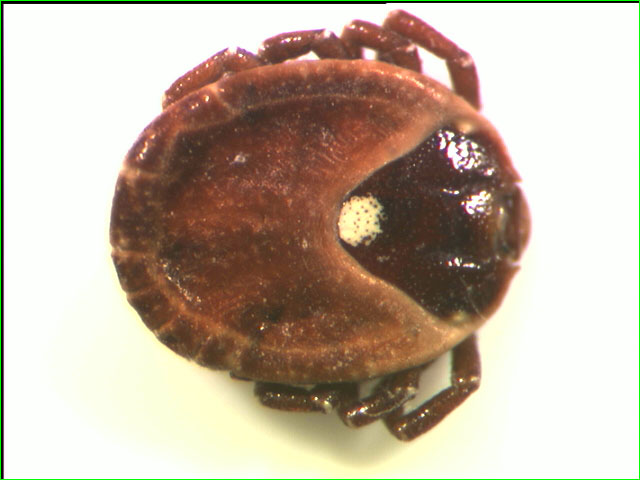It looks like Lyme disease isn’t the only thing Canadians need to worry about contracting from ticks. A bite from the Lone Star tick can trigger an allergy to red meat, and the tiny bug is making its way into Canada.

For decades, scientists kept a watchful eye over the Lone Star tick and its potent bite. The tick that’s widespread in the East, Southeast and Midwest United States got its nickname from the small white “star” that’s on the back of the female bugs.
In the past few months, the tick – and its victims with newfound meat allergies – have cropped up not just in the Midwest and southern states, but farther north into Minnesota, New Hampshire and Maine.
Canadian experts say Lone Star ticks are on course to make their way into Canada, whether carnivores like it or not.
We’ve already seen the insect cross the border, too.
Dr. Vett Lloyd, a University of New Brunswick professor, began collecting tick samples in 2012. So far, she’s come across two Lone Star ticks in Eastern Canada. Ontario reported a third incident, too.
“It’s more than zero but we’re not drowning in them by any means. They’ve been dropping off birds or large mammals. They’re not established at this point but they may become established with climate change,” she warned.
“It’s almost inevitable” that they end up in Canada, she said.
READ MORE: Oregon mom urges parents to check for ticks after daughter faced tick paralysis
Dr. Janet Sperling, an entomologist and University of Alberta researcher, told Global News she comes across the “occasional report,” too.
“Ticks are moving northward so we do expect these ticks to arrive in Canada and exactly what is causing this meat allergy, we haven’t done much research into exploring. We’re busy with the problems we already know we have,” Jim Wilson, president and founder of the Canadian Lyme Disease Foundation, told Global News.
Dr. Lloyd collected two Lone Star tick samples. The first image is a tick missing its head due to removal from the human it bit in New Brunswick. The second is a swollen tick, full from its last meal. It bit a pet dog along the borders of New Brunswick, Quebec and Maine.
Lone Star ticks and allergies
It isn’t quite clear why the Lone Star tick’s bite sparks meat allergies in some people but enough case reports have surfaced to know it’s a common outcome.
A sugar in the Lone Star tick’s saliva triggers an immune response reprogram in humans. That shift triggers an allergy to all types of red meat, such as beef, lamb and pork.
- Health task force blasted over ‘dangerous guidance’ for cancer screenings
- Dentists hesitant to sign up for federal dental plan; seniors advised to look at all options
- David Chang’s Momofuku to stop ‘chile crunch’ trademark battle after outcry
- Over 25% of young Canadian deaths linked to opioids amid pandemic: study
Chicken, turkey and fish are OK, though, according to Jason Tetro, a Canadian microbiologist and bestselling author.
READ MORE: More ticks means an increase of Lyme disease across Canada – thanks to climate change
“Once you get a tick bite, there’s a chance you’ll develop this meat allergy. The reason why it can be permanent is because it changes the way your immune system reacts to this component in meat,” he told Global News.
Red meat contains a few sugars – it’s galactose-alpha 1,3 galactose, or “alpha-gal,” that’s the culprit. Patients grappling with the allergy brought on by their tick bite end up swearing off red meat.
“I’ve never really seen what we call a class shift in immunity quite like this. In this particular case, it’s one bite leading to a major allergy – this is something I’ve never seen before,” Tetro said.
In case studies, patients who normally eat red meat would suddenly break into hives, develop vomiting or diarrhea, grapple with fever, cramps and body aches, or even go into anaphylactic shock, Tetro said.
“It’s horrible. We need to find a way to identify what the protein in tick saliva is and if there’s a way we may be able to combat it so we can give someone treatment after a tick bite to stop this shift from happening,” Tetro said.
Lloyd has seen red meat allergies in those who ended up with Lone Star bites, too.
READ MORE: Kris Kristofferson says his memory loss was due to ticks, not dementia
“It does all the things you expect an allergy to do – rashes, hives, shortness of breath. It can be severe. One person I knew who had it, she was awfully sick until she finally figured it out,” Lloyd said.
The Public Health Agency of Canada is aware of the strange allergic reaction.
“This type of allergy is rare, and it is not against the red meat per se, but rather against a sugar found in red meat called alpha gal. Alpha gal is also found in the saliva of a biting tick and it is believed that that is how this type of rare allergy is triggered. All mammals carry the alpha gal sugar with the exception of primates (humans), which is why they react to the sugar in other mammalian meat,” Anna Maddison, a PHAC spokesperson, said in an email to Global News.
Lone Star ticks are aggressive, too
In Canada, there are traditionally a handful of ticks at play, such as the western black-legged ticks, or deer ticks, wood ticks and American dog ticks.
And then there’s the Lone Star tick. They’re typically bigger in size and, in turn, feed more because they need a lot of energy to reproduce.
They’re dubbed as aggressive compared to their relatives.
READ MORE: Uptake of Lyme disease cases in Canada, experts warn
The conventional tick hangs onto grass and waits for its next victim to approach them — whether it’s a human, dog or wildlife.
“Lone Star ticks will walk or run towards a meal, so they’re aggressive ticks. The last one in the lab was alive and even though she was fully fed, the moment I started handling her, she escaped the vial and ran towards me,” Lloyd said.
“There’s no such thing as a good tick, but these are the worst,” she said.
What are health officials doing?
In May, the federal government poured $4 million into the country’s first-ever Lyme disease framework. It’s a guide that will help Ottawa with establishing national surveillance, issuing guidelines and educating the public about the illness tied to tick bites.
The Public Health Agency of Canada says that it’s anticipating the “possible expansion” of the Lone Star tick’s range into Canada. It’s even developed a risk modelling method and is researching the possible impact of warming climates on the tick’s populations.
“We aim to be able to identify locations in Canada that may become suitable for the Lone Star tick in the near future. We are also using our passive tick surveillance data to study where Lone Star ticks are being carried into Canada by migratory birds,” Maddison said.
READ MORE: Federal government to pour $4 million into first-ever Lyme disease framework – here’s why
The number of Lyme disease cases has shot up across Canada over the last seven years, from 144 in 2009 to a high of 917 in 2015. Blacklegged ticks carry the bacteria that causes Lyme disease, and transmit it to humans through bites. So, more reports of Lyme disease are partly due to more awareness, but also due to more ticks.
It’s been a nasty year for ticks all around, according to Wilson.
His organization sells tick removal kits online – in 2016, he sold 4,000 kits in an entire year. So far, he’s sold 7,000 kits in the month of May alone.
Ticks and Lyme disease
Unlike mosquitoes that can transfer West Nile to humans with a single bite, the tick has to be attached to the body for at least 24 to 36 hours, according to public health officials. That’s enough time for the bacteria in the insect’s gut to make its way into its human host.
Symptoms crop up within three to as long as 30 days: a rash at the site of the bite, headaches, fevers, muscle aches and chills.
These symptoms appear to be the onset of Lyme disease. The condition was first discovered in the late 1970s and was named after the town where the initial cases were diagnosed in – Lyme, Conn.
READ MORE: Here’s what you need to know about springtime allergies in Canada
If it’s left untreated it could move onto the second stage of the disease.
The tick’s victim is left with multiple skin rashes, arthritis, heart palpitations and central and peripheral nervous system disorders.
A third and final stage is recurring arthritis and neurological problems, according to Health Canada.
The little insects may be the predominant culprit of Lyme disease but they’re also responsible for carrying at least three other disease-inducing agents.
If you get bitten by a tick, remove it carefully and hang onto the insect so that doctors can help decipher what type of tick bit you, the experts say.
How to protect yourself against ticks
- Wear light-coloured clothing. It makes ticks easier to see and remove before they can attach to feed.
- Wear long pants and a long-sleeved shirt, closed footwear and tuck your pants into your socks.
- Use a tick repellent that contains DEET. Apply it to your skin and outer clothing.
- Examine yourself thoroughly for ticks after a day out and use a mirror to check the back of your body.
Information provided by the Ontario Ministry of Health and the Public Health Agency of Canada
— With files from Leslie Young and Kevin Nielsen
carmen.chai@globalnews.ca
Follow @Carmen_Chai
















Comments